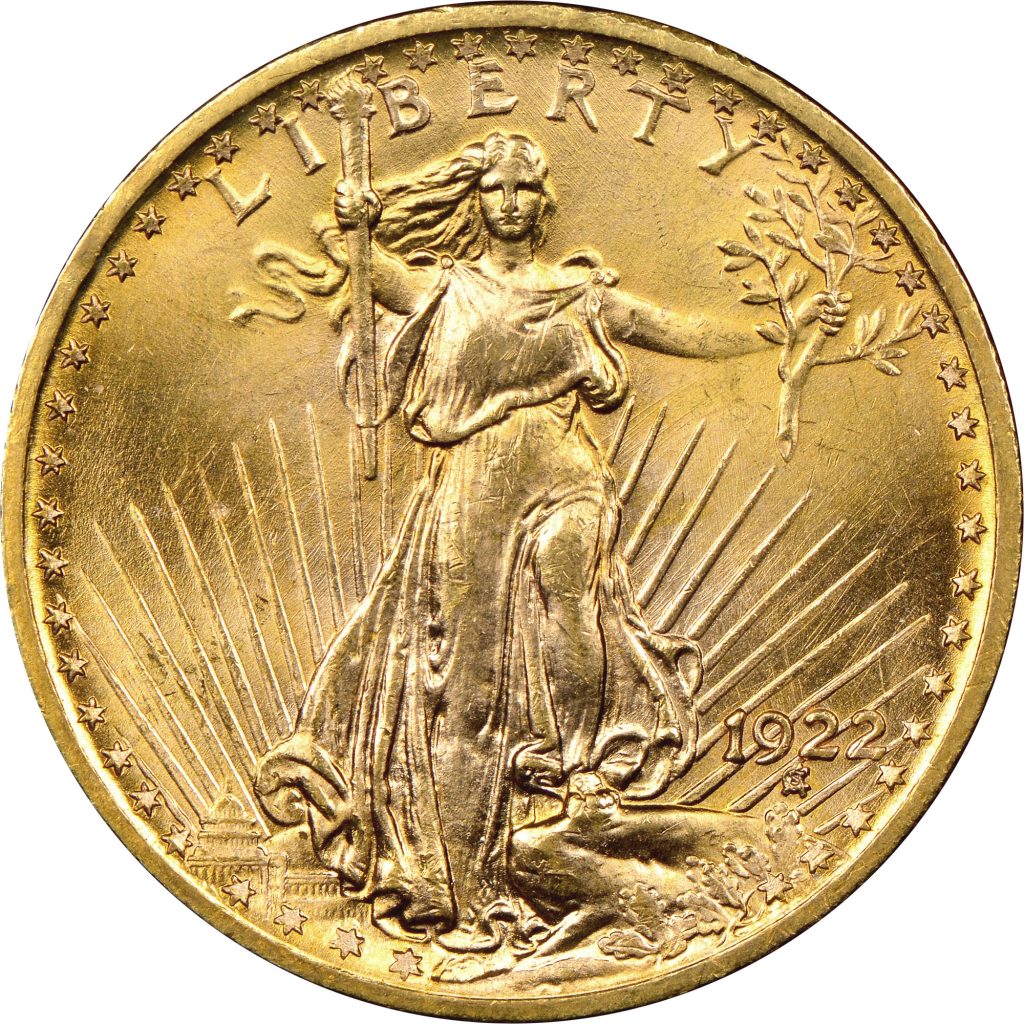Blog
$20 Saint-Gaudens
Overview
The beloved $20 Saint-Gaudens “Double Eagle” is the last coin of this denomination ever minted by the U.S. This piece is 1 of 4 pieces in the “Indian Head” series along with the $2.5, $5 and $10 Indian Head Gold pieces.
- Obverse: Lady Liberty holding a torch and olive branch; rays of the sun in background.
- Reverse: Eagle flying; rays of the sun in background.
- Years: 1907-1916 & 1920-1933
- Mints: D, S and P
History
In the early 1900s, President Theodore Roosevelt decided he wanted an entire overhaul of the nation’s gold currency. He sought out the minting of a new Double Eagle – $20, Eagle – $10, Half Eagle – $5, Quarter Eagle – $2.5, and a new cent. This specific piece, the $20 Saint-Gaudens was to replace the $20 Liberty Head which had been in circulation since 1849.

This legendary coin was designed by and is named after famed sculptor Augustus Saint-Gaudens. In 1907, President Roosevelt commissioned him to design all 4 new Eagle coins and the new cent. The original design for the new $20 coin called for all the features on the obverse and reverse to be raised. The depection of Lady Liberty is noticably 3D and she appears to be taking a stride right out of the coin.
In order to accomplish the raised design with just 1 oz of gold, the U.S. Mint had to use a thicker coin than usual with a smaller diameter. Then to create the raised features, the mint had to strike the coin numerous times – in some cases up to 11 strikes. In addition to this production being inefficient, these coins could not be stacked like normal coins, which caused problems for the banks taking them in. Due to the these issues, it was decided to change the $20 Saint-Gaudens to a regular size coin with shallow features. A $20 Saint Gaudens with the raised design from this first round of minting is referred to as a High Relief.
Only 11,250 High Reliefs were minted. These are very rare and were only produced at the Philadelphia Mint. The average High Relief sells for tens of thousands of dollars and they go as high as the hundreds of thousands of dollars. In addition, one small percentage of these High Reliefs had features that were raised even higher than the others (Ultra High Reliefs) and are valued in the 2-3 million dollar range. Unfortunately, Saint-Gaudens. passed away shortly after designing this coin and did not live to see the minting of this piece, and therfore also was not a part of the redesigning process for the new shallow design.
The new shallow design of the $20 Saint Gaudens was minted at the Philadelphia and Denver mints without the motto “In God We Trust”. This was because a line in the Coinage Act of 1892 amended the existing law that required the motto. President Roosevelt realized this and decided to leave the motto off of the coin. This led to a public outcry and quickly one year later the design was changed once again to add the motto to the reverse of the coin. These coins without the motto are referred to as “No Motto”. Despite only being minted for one year, this batch of the $20 Saint-Gaudens are not particularly rare.
The newest design with the motto was finalized in 1908 and it was produced until 1916 and then again from 1920-1933 at the Philadelphia, Denver and San Francisco mints. The U.S. government took a 3 year break from production from 1917-1919 because of the lack of a need for gold coins due to the economic unrest of World War I. Minting for the $20 Saint Gaudens started up again in 1920 as the economy turned for the better and began booming.
In 1933, due to the scarcity and high prices of gold during the Great Depression, President Theodore Roosevelt’s distant cousin, President Franklin Delano Roosevelt, ended the minting of gold coins in the country – thus ending the production of the $20 Saint-Gaudens. The supply of gold was so low throughout the country, that part of FDR’s order instructed that the 1933s that were already minted should be melted down and not enter circulation. However, a very small percentage did find their way into the hands of some collectors; presumably all by people who went down to the mints themselves and exchanged $20 Liberty Heads for them before FDR’s order. The U.S. Government however denied having records of these transactions and worked hard to hunt down the collectors who had their hands on them and confiscated and melted each one. The one and only legally recognized transaction of a 1933 $20 Saint Gaudens occurred in 2002 and sold for $7,590,020.
Some of the other most valuable date and mint mark combinations are the 1927-D, 1909-D, 1920-S, 1921-P, 1925-S and of course any High Relief.
It is a shame that Saint-Gaudens. did not live long enough to see his coin become so loved and widely acclaimed for its innovative design and beauty, but his name undoubtedly lives on with this historic coin!
At Atlas we have access to a wide variety of $20 Saint-Gaudens in a variety of dates and mint marks.

